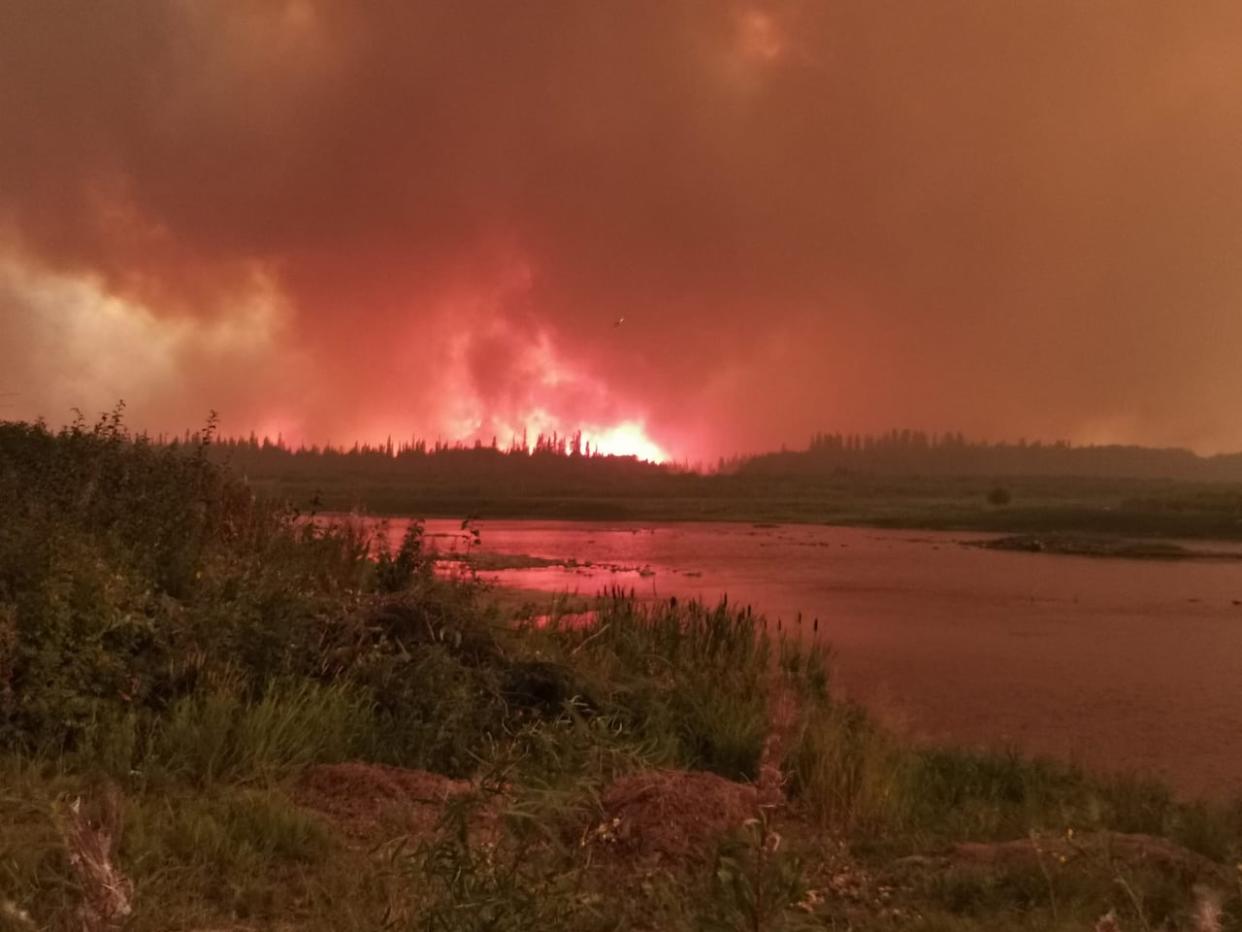Wildfire likely burned structures west of Hay River but spared town: fire official

The wildfire bearing down on Hay River, N.W.T., burned a cabin and a travel trailer west of the town near Great Slave Lake, but spared the town itself, a fire official said in an update Saturday morning.
Friday afternoon and evening, the fire closed much of the 10 kilometres between it and the community of about 3,500 people after a "blow-up event" sent a wall of flame heading up the highway toward Hay River.
It's now a kilometre west of the Hay River airport and 1.5 kilometres west of town centre. It's three kilometres east of River Wood Estates and about seven kilometres south of the K'átł'odeeche First Nation reserve.
As of Saturday afternoon, N.W.T. Fire said structures in Hay River had been spared, along with the water treatment plant. The fire agency also believes there were no structures lost in West Channel.
"The fire progressed a significant distance parallel to the highway — it's very close to town," fire information officer Mike Westwick said Saturday, just after 8 a.m. MT.
A Saturday afternoon fire update confirmed a cabin and travel trailer west of the town had burned, and said fire crews expect more extreme weather Sunday, with temperatures of 30 C and gusting winds that could push the fire north and east.
"Our team alongside the Town of Hay River are doing everything possible to protect the community and reduce those risks — with all tactics on the table," wrote N.W.T. Fire.
A second evacuation order was issued Friday for those remaining in Hay River.
The military loaded two Hercules Aircraft flights with people and pets including Mayor Kandis Jameson.
'Grim circumstances'
Jameson said she and her dogs were on one of the Hercules flights out of the community Friday night.
"It was challenging to leave under such grim circumstances," she stated. "Waking this morning, we see that Hay River has survived in much better condition than any of us imagined last night."
She thanked the town's fire department, led by Fire Chief Travis Wright, for all the work they did to build fire protection lines before the wildfire flared up, along with fire crews from many other communities.

A satellite view of the fire threatening Hay River, N.W.T., on Aug. 23. Fire activity began picking up later in the week, and on Aug. 25, the N.W.T. government said anyone remaining in the town who isn't part of a fire crew needed to leave immediately for their own safety. (Sentinel-2/European Space Agency)

The wildfire south of Hay River, N.W.T., exploded into action Friday afternoon as high winds and heat hurtled it north toward Great Slave Lake. (Sentinel-2/European Space Agency)
On Friday, N.W.T. Fire described a "blow-up event" as the catalyst that sent the wildfire raging northward. That event was a combination of high, gusting winds and hot temperatures reaching roughly 30 C.
"We had some absolutely extreme southwest winds," Westwick said Saturday, adding they were gusting significantly higher than 50 kilometres per hour at times.
"It was quite a scene there yesterday — the wind bearing down on us, the skies getting progressively darker as the fire activity was pushed very hard by those winds."
'Pretty close to hell last night'
Gene Hepditch is one of a handful of people who stayed in Hay River despite government orders.
There are about eight people camped down by the lake, according to Hepditch.
He described Friday night as smoky with the sky "every colour you can name."
"She was pretty close to hell last night," said Hepditch. "It was a little hectic, a little worrisome."
Hepditch said he and the others plan to evacuate by boat if the fire gets too close.

Evacuees from Hay River wildfires and Canadian Forces members arriving at Edmonton International Airport, Edmonton, Alta., on Friday. (MCpl Paul McCahon/Canadian Forces)
The situation forced the town to issue another order for anyone who wasn't part of a firefighting crew to leave immediately for their own safety. With an estimated 100 residents left in town at the time, Westwick said more than 60 people got out on two Hercules flights and 30 to 40 cars left as well.
He said all the work crews had done last week to build fire breaks, put up sprinkler lines and drop fire retardant helped keep the town itself safe.
Firefighters worked through the night to put out hotspots on structures in areas the fire hit. Today, they'll be determining where the fire spread.
"Where we're sitting, it's the best of a bad situation in many ways. It could have been so much worse," said Westwick.


